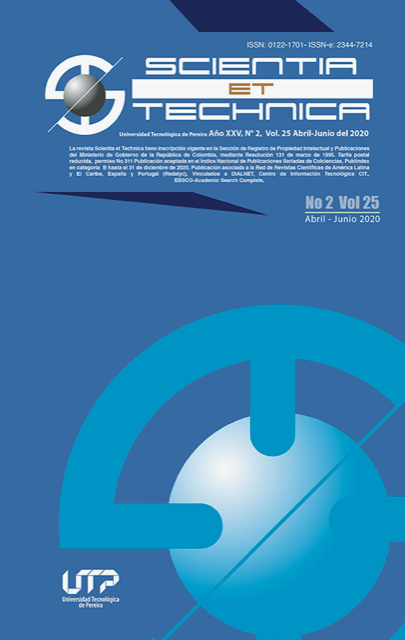Detection of structural alterations in metal bodies: An approximation using Fourier transform and principal component analysis (PCA)
DOI:
https://doi.org/10.22517/23447214.23501Keywords:
Fast Fourier transform (FFT), Metal bodies, principal components analysis (PCA), structural alterationsAbstract
In this theme some advances have been developed, verified in the background, where attempts have been made to determine the existence of structural alterations such as perforations, defective welding and dents in metal structures; a pattern of mechanical vibration that allows to differentiate each alteration has not yet been clearly defined. In this work, the data taking was carried out taking into account the position of the sensors, two beams were added without alteration, in order to be able to interact with the five configurations, which were adopted for the experimental design. To the tests of repeated measurements, in each configuration, analysis (ANOVA) was used for the validation of NULL hypotheses, and thus to determine the number of test to be treated. After having the defined matrices representing each configuration, in each anomaly, it is necessary to apply the principal component Analysis (PCA), to the data obtained by the calculation of the fast Fourier transform (FFT). And thus determine the number of components by means of three Criteria (Jollife, Kaiser and PVA), using a classification algorithm, which evaluates the percentage of classification vs lower standard deviation. In this analysis the descriptors were not calculated but the main components of each criterion were taken as a description tool. The process of extraction of characteristics was fundamental to determine the proper configuration in each alteration (fissure, welded, perforated, deformed). On the other hand, statistical parameters were calculated (average, standard deviation, variation factor, Euclidean distance) of each anomaly. Taking as descriptors.
Downloads
Downloads
-
Vistas(Views): 343
- PDF Descargas(Downloads): 266
Published
How to Cite
Issue
Section
License
Copyrights
The journal is free open access. The papers are published under the Creative Commons Attribution / Attribution-NonCommercial-NoDerivatives 4.0 International - CC BY-NC-ND 4.0 license. For this reason, the author or authors of a manuscript accepted for publication will yield all the economic rights to the Universidad Tecnológica of Pereira free of charge, taking into account the following:
In the event that the submitted manuscript is accepted for publication, the authors must grant permission to the journal, in unlimited time, to reproduce, to edit, distribute, exhibit and publish anywhere, either by means printed, electronic, databases, repositories, optical discs, Internet or any other required medium. In all cases, the journal preserves the obligation to respect, the moral rights of the authors, contained in article 30 of Law 23 of 1982 of the Government Colombian.
The transferors using ASSIGNMENT OF PATRIMONIAL RIGHTS letter declare that all the material that is part of the article is entirely free of copyright. Therefore, the authors are responsible for any litigation or related claim to intellectual property rights. They exonerate of all responsibility to the Universidad Tecnológica of Pereira (publishing entity) and the Scientia et Technica journal. Likewise, the authors accept that the work presented will be distributed in free open access, safeguarding copyright under the Creative Commons Attribution / Recognition-NonCommercial-NoDerivatives 4.0 International - https://creativecommons.org/licenses/by-nc-nd/4.0/deed.es license.



